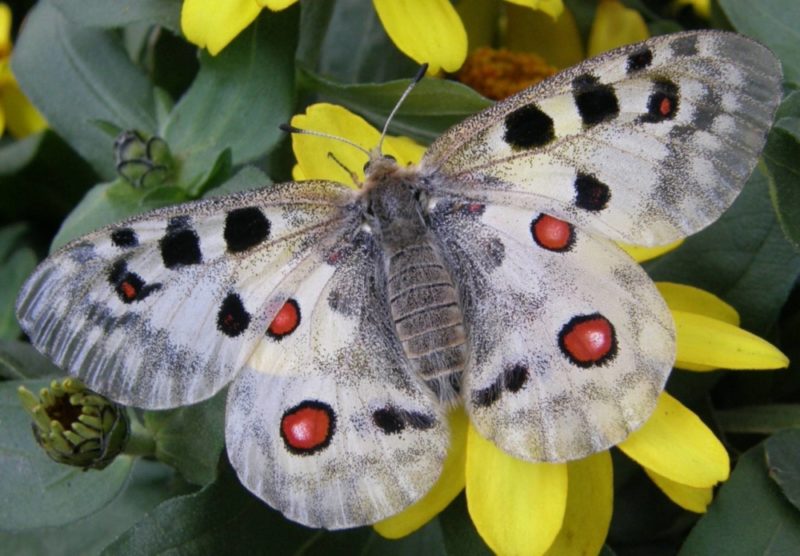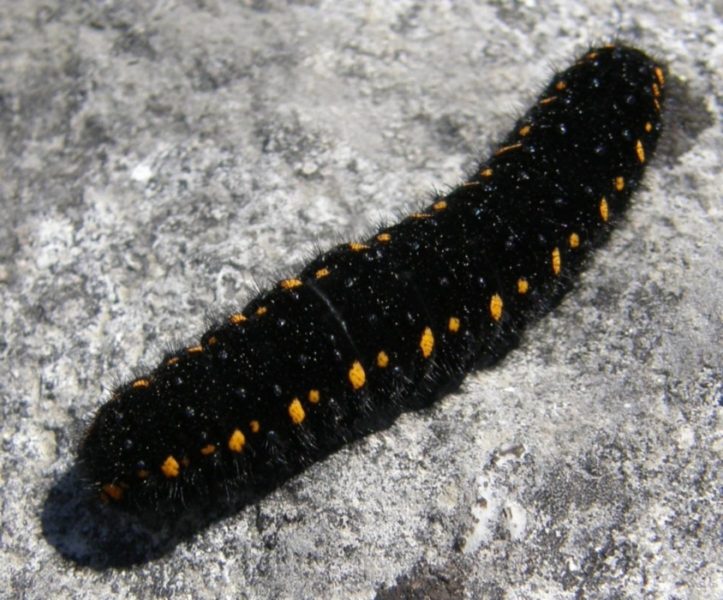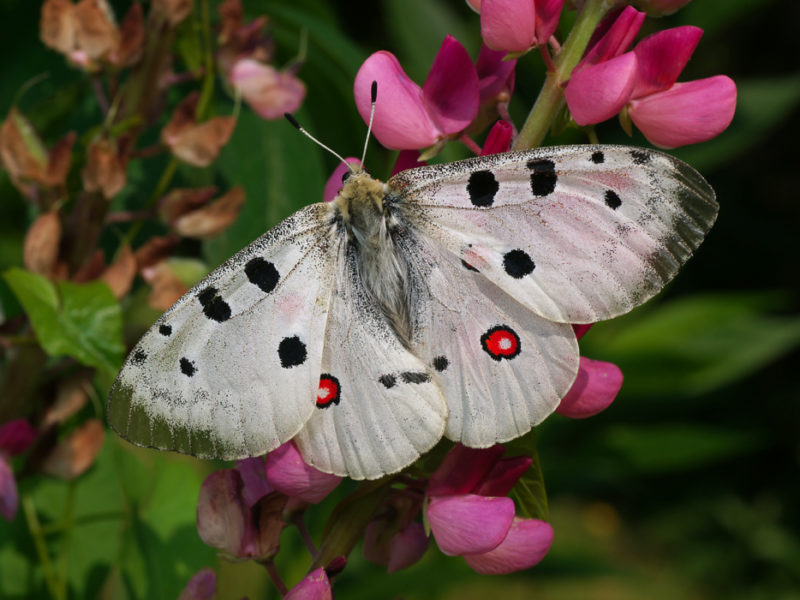The insect got its scientific name in honor of the son of Zeus and brother Artemis - the god of light, the patron of art from ancient Greek myths. Apollo butterfly is one of the largest, known around the world. In Europe, the number of species is constantly declining; it is almost impossible to find this “divinely” beautiful insect in nature.
Material Content:
Butterfly lifestyle and habitat
Apollo is active during daylight hours. This is the way of life for all day butterflies. Insects fly and feed in June – August; in warm regions they remain active until September.
Adults can be seen on fodder plants in sunny weather, the rest of the time butterflies hide.
Apollo's habitat: sunny meadows, forest edges and glades of forests with a predominance of oak and pine, valley of mountain rivers and streams. Butterflies of this species are found in summer on scree, rocky steep slopes, on wastelands.
The species range is not continuous. The main habitats of insects are mountain ranges up to a height of 2200 mm above sea level: the Pyrenees, Alps, Carpathians, and the Caucasus. Small colonies of these representatives are found in France, in the south of the countries of the Scandinavian Peninsula, Kazakhstan, Mongolia, the Urals, and Turkey.
Appearance and behavior
Parnassius apollo is a large flying insect with a relatively thin body. The span of the front wings is from 5 to 9 cm. The body of the butterfly is densely covered with hairs resembling animal hair. The eyes are convex, large, club-like tendrils.
The body size of the female Apollo is smaller, the color is slightly darker. The male is larger, with a wingspan of up to 10 cm. Another sign of sexual dimorphism: the male is more “furry”.
The species belongs to the Sailboats family. These are butterflies that fold wings at rest (lift up). Representatives of such insects live in large numbers in tropical countries. In Russia, no more than 40 species have been identified.
Brief description of the color of Apollo (imago):
- The pattern of the front wings consists of 5 black rounded spots that stand out against the general light background.
- There are few white scales at the ends of the wings; therefore, they appear translucent.
- Two red spots on the hind wings in the form of rings with a black border and a white center.
- The antennae on the head are painted gray.
- The color of the young is yellowish.
A butterfly from the sailing family is easy to recognize by the pattern on the wings. Entomologists have described more than 600 spot distribution options. Even individuals in the same region have differences in pattern.
Apollo is inedible for birds, coloring warns birds: "Do not eat me!". In the event of a threat, the butterfly descends to the ground, lays on its back and quickly spreads its wings. Red spots are a warning to enemies. In addition, the insect scratches the lower part of the wings with its paws, achieving the appearance of sounds like hissing. In case of danger, the butterfly can give off an unpleasant smelling substance.
In its flight, the Apollo is always unhurried, gradually flapping its wings several times, then plans, hovering over bright flowers and large boulders, often sits on warm stones with spread wings - “tans”.
Apollo breeding
Males begin to search for a girlfriend in 2-3 days after they appear from the chrysalis. They fly for a long time and soar in the air at a low altitude, looking for a partner. After fertilization, the female lays eggs at various places of the selected feed plant (stonecrop), as well as next to it, on the ground. Fertility of the female is from 80 to 100 eggs. They are white in color, rounded in shape, with a granular surface. Winter caterpillar spend in the egg or outside the shell.
Caterpillars and pupae
Larvae come from April to May, prefer fleshy stonecrops as food. At the beginning of feeding, the caterpillars are black with white spots on the sides and characteristic tufts of black hairs. Active day, night and in bad weather, they prefer to hide in dry grass, under large boulders. Adult caterpillars are large (up to 5 cm), velvety black, with a chain of orange spots of different sizes and bluish warts on body segments.
Pupation occurs on an edible plant or under stones. The duration of this period varies greatly - from 7–8 days to 2-3 weeks. The length of the pupa is from 1.8 to 2.5 cm. The cocoon is thick, rounded, brown in color, with time becoming covered with a powdery coating.
Diet
Apollo distribution is tied to fodder plants. Adults feed on nectar of flowers. Butterflies visit white stonecrop buds (rabbit cabbage), purple clover heads, milk thistle, pink oregano umbrellas, blue cornflower baskets.
Large insects require a lot of food. Apollo find the most food on the sunny edges, grassy meadows. The number of eggs laid by a female depends on good nutrition.
The main plant that feeds on the caterpillar is different varieties of stonecrop (white, large, purple, Eversa, caustic, tenacious), young.
Saving view
The destruction of the habitats of these stunningly beautiful insects, the steady decrease in the area of herbs and the replacement of natural landscapes with cultural ones, are the main reasons for the disappearance of Apollo in a significant part of its former range. Parnassius apollo "registered" on the pages of the Red Book of Russia, Germany, Belarus, Scandinavian countries, similar environmental documents of a number of other states, in certain regions within the country of "residence".
In Europe, this species of beautiful insects is recognized as endangered.
The reason for the reduction in numbers is also considered the attachment of butterflies to habitats.This is due to the fact that only certain feed plants are suitable for caterpillars. Apollo lead a mostly sedentary lifestyle, do not go in search of more suitable sites.
Other factors that violate the normal living conditions of this species include:
- global warming, climate aridization (desertification);
- forest area reduction;
- the destruction of glades and meadows;
- active plowing of land.
In winter, when there is a sufficient increase in temperature, the caterpillars prematurely leave the egg shells. There is no food yet, the larvae die from cold and hunger.
The main measures for increasing the population of Apollo are associated with the restoration of biotopes. In forests there should be more light glades and clearings, in meadows - areas of nectariferous forbs suitable for butterflies for a prosperous existence, fodder plants for caterpillars.
Interesting Facts
The title of the book by the famous writer Y. Arakcheev "In Search of Apollo" is dedicated to a large person. For the author, this insect has become a symbol of all the beautiful that nature has created: “The subject of my Dream. Mountain butterflies that "occur locally and in small numbers" and "fly only in sunny weather."
Very interesting facts about amazing butterflies are reported by entomologists:
- Red spots located on the bright wings of butterflies are a signal of danger to birds. Hemolymph insect contains toxins that are dangerous to birds.
- After the fertilization process, a small appendage consisting of chitin is formed on the lower abdomen of the female Apollo. This is a kind of "chastity belt" that prevents repeated mating with an individual. The scientific name of this body is sphragis.
- Caterpillars have a hidden gland in the shape of a horn, which in case of danger appears in the back of the head. An unpleasantly smelling liquid is released that scares birds away.
Apollo is a welcome object for entomologists and amateur collectors. If in a country or region a butterfly is listed in the Red Book, then it is strictly forbidden to catch it.
















